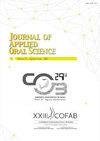白念珠菌菌株疏水性和牙本质粘附能力的比较分析
IF 2.6
3区 医学
Q2 DENTISTRY, ORAL SURGERY & MEDICINE
引用次数: 0
摘要
目的粘附在牙本质上是微生物根管成功定殖的第一步。细胞疏水性似乎对念珠菌粘附表面有一定影响。通过体外研究测量细胞表面疏水性,并调查从根管和舌背分离的白色念珠菌菌株对人类牙本质的粘附能力。细胞表面疏水性是通过评估细胞从水相迁移到烃相的百分比来估算的。使用接触角测量仪在牙本质表面采用无柄液滴技术测量接触角。我们还研究了粘附能力与疏水性之间的相关性。结果尽管细胞表面疏水性存在一些种内差异,但大多数分离物都具有中等疏水性。在考虑分离位点时,该参数没有明显差异。根管酵母菌和舌背酵母菌都能粘附在牙本质上。在菌株的分离部位和粘附性之间没有发现任何关联。此外,细胞表面的疏水性与粘附能力也没有相关性。结论 虽然疏水性会以多种方式影响白色念珠菌的毒力,但本研究表明,这一参数本身并不能很好地预测对牙本质的粘附能力。本文章由计算机程序翻译,如有差异,请以英文原文为准。
Comparative analysis of hydrophobicity and dentin adhesion ability in Candida albicans strains.
OBJECTIVE
Adhesion to dentin is a first step for a successful microbial root canal colonization. Cell hydrophobicity seems to have some influence in the Candida species adhesion to surfaces. To measure cell surface hydrophobicity and to investigate the adherence ability to human dentin among Candida albicans strains isolated from root canal and lingual dorsum via an in vitro study.
METHODOLOGY
adhesion was quantified in function of dentin area covered by blastospores and/or hyphae presence detected by epifluorescence microscope. Cell surface hydrophobicity was estimated by assessing the percentage migration of cells from an aqueous phase to a hydrocarbon phase. Contact angles were measured by the sessile drop technique on the dentin surface using a contact angle measurements apparatus. We also examined the correlation between adhesion ability and hydrophobicity.
RESULTS
although there was some intra-species variation in cell surface hydrophobicity, most isolates were characterized by moderate hydrophobicity. There was no significant difference in this parameter when the isolation niche was considered. Both root canal and lingual dorsum yeasts were able to adhere to dentin. No association was found between the strains' site of isolation and adhesion. Moreover, cell surface hydrophobicity and adhesion ability were not correlated.
CONCLUSION
although hydrophobicity can influence Candida albicans virulence in many ways, this study suggests that this parameter by itself was not a good predictor of adhesion to dentin.
求助全文
通过发布文献求助,成功后即可免费获取论文全文。
去求助
来源期刊

Journal of Applied Oral Science
医学-牙科与口腔外科
CiteScore
4.80
自引率
3.70%
发文量
46
审稿时长
4-8 weeks
期刊介绍:
The Journal of Applied Oral Science is committed in publishing the scientific and technologic advances achieved by the dental community, according to the quality indicators and peer reviewed material, with the objective of assuring its acceptability at the local, regional, national and international levels. The primary goal of The Journal of Applied Oral Science is to publish the outcomes of original investigations as well as invited case reports and invited reviews in the field of Dentistry and related areas.
 求助内容:
求助内容: 应助结果提醒方式:
应助结果提醒方式:


